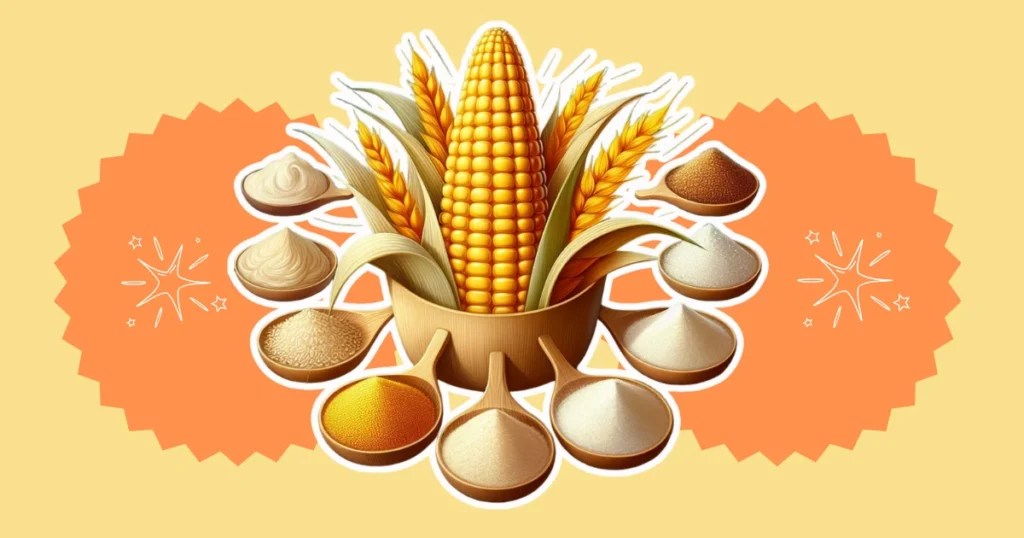
Cornstarch is a common cooking and baking ingredient known for its ability to thicken sauces, soups, and gravies, as well as provide structure and texture in baked goods.
However, if you run out of this kitchen staple or are looking for alternatives due to dietary restrictions or preferences, do not worry! There are numerous substitutes for cornstarch that can achieve similar results without sacrificing taste or texture. In this article, we will look at the top 10 cornstarch alternatives that you can easily incorporate into your recipes.
1. Arrowroot powder
Arrowroot is a starchy flour (also called arrowroot powder) derived from the roots of plants in the Maranta genus, which are typically found in tropical regions.
Arrowroot powder is often used as a substitute for cornstarch due to its neutral taste and its ability to thicken effectively. One of the advantages of using arrowroot powder is that it creates a smooth texture without altering the flavor of the dish. This makes it particularly well-suited for delicate sauces and custards. To achieve comparable results, it is recommended to use twice as much arrowroot as cornstarch. Additionally, arrowroot is gluten-free, making it a suitable option for individuals who follow a gluten-free diet.
2. Wheat flour
The production of wheat flour involves the grinding of wheat grains until they are transformed into a fine powder. Unlike cornstarch, wheat flour contains protein and fiber in addition to starch. This means that while you can substitute cornstarch with flour, you will need to use a larger quantity to achieve the same thickening effect.
The usual recommendation is to employ twice the quantity of white flour in comparison to cornstarch for the purpose of thickening. In instances where a recipe requires 1 tablespoon of cornstarch, it is advised to incorporate 2 tablespoons of white flour.
Wheat and whole-grain flour have a higher fiber content compared to white flour. Therefore, if you attempt to thicken a recipe using these flours, you will likely need to use a greater amount to achieve the desired consistency.
When thickening recipes with wheat flour, it is advisable to mix it with a small amount of cold water first to create a paste. This will prevent the flour from clumping together when added to the recipe.
It is important to note that wheat flour is not gluten-free, so it is not suitable for individuals with gluten-related disorders.
3. Ground flaxseeds
Ground flaxseeds have high absorbency and create a gel-like texture when combined with water. However, the texture of flax may be slightly gritty compared to the smoothness of cornstarch.
Despite this, flaxseeds are rich in soluble fiber, making them a beneficial alternative to flour for increasing the fiber content of your recipe. For thickening purposes, consider replacing cornstarch with a mixture of 1 tablespoon of ground flaxseeds and 4 tablespoons of water, which can substitute approximately 2 tablespoons of cornstarch.
4. Tapioca
Tapioca is a processed starch product obtained from cassava root, a root vegetable found throughout South America. Tapioca is a processed starch derived from cassava root, a root vegetable common throughout South America. Tapioca flour is another great alternative to cornstarch. It produces a glossy finish and a slightly chewy texture, making it perfect for pies, puddings, and fruit fillings. Replace the cornstarch with tapioca flour in a 1:1 ratio, but keep in mind that it may take a little longer for the tapioca to cook down to its full thickening potential.
5. Potato starch
Cornstarch can be substituted with potato starch. It is derived from crushed potatoes, which are then dried and turned into a powder. Similar to arrowroot, potato starch is gluten-free as it is not made from grains. Although it is a refined starch, it is low in fat and protein but high in carbohydrates.
One advantage of potato starch is that it has a neutral taste, so it will not alter the flavor of your dishes. When substituting cornstarch with potato starch, you should use a 1:1 ratio. For example, if your recipe calls for 1 tablespoon of cornstarch, replace it with 1 tablespoon of potato starch.
It is important to note that when using root or tuber starches like potato or arrowroot, it is recommended to add them later in the cooking process. This is because they thicken quickly and absorb water faster than grain-based starches. Overheating them for too long can cause them to lose their thickening properties.
6. Rice flour
Rice flour is a fine powder made from ground rice grains, offering a suitable alternative to cornstarch, especially for those with gluten intolerance. It provides excellent thickening properties and is commonly used in Asian cuisine for sauces, gravies, and desserts. Replace cornstarch with rice flour in equal amounts, adjusting the quantity based on the desired thickness of the dish.
7. Glucomannan
Glucomannan, a powdered soluble fiber extracted from the konjac plant’s roots, is highly absorbent and creates a dense, transparent, and scentless gel when combined with hot water. Being a pure fiber, glucomannan is devoid of calories and carbohydrates, making it a favored alternative to cornstarch for individuals adhering to a low-carb diet.
Furthermore, it acts as a probiotic by nourishing the beneficial bacteria in the large intestine, thereby aiding in maintaining a healthy gut. Recent research has shown that the daily consumption of 3 grams of glucomannan can potentially lower LDL (bad) cholesterol levels by up to 10%. However, when used as a thickening agent, it is unlikely that you will consume such a large amount due to its potent thickening properties compared to cornstarch (1).
People generally use a quarter of a teaspoon of glucomannan for every two teaspoons of cornstarch. It thickens at relatively low temperatures, so it is advisable to mix it with a small amount of cold water before adding it to your food to prevent clumping when in contact with hot liquids.
8. Xanthan gum
Xanthan gum, derived from fermenting sugar with Xanthomonas campestris bacteria, is a vegetable gum. After fermentation, it is transformed into a gel and then dried to create a powder that can be utilized in cooking. Even a small quantity of xanthan gum has the ability to significantly thicken a liquid (2).
It is important to mention that consuming large amounts of xanthan gum may lead to digestive problems for certain individuals. However, when used as a thickener, it is unlikely that you will consume excessive quantities of it.
To ensure optimal results, it is advisable to use a small amount of xanthan gum and gradually incorporate it into your recipe. It is crucial to exercise caution and avoid using an excessive amount, as this may result in a slightly slimy texture for the liquid.
9. Guar gum
Guar gum, derived from guar beans, is a vegetable gum that is produced by removing the outer husks of the beans and collecting the central, starchy endosperm. This endosperm is then dried and ground into a powder. Known for being low in calories and high in soluble fiber, guar gum is an effective thickener. Some individuals opt for guar gum over xanthan gum due to its more affordable price. However, it is important to note that, like xanthan gum, guar gum is a potent thickener. It is recommended to start with a small amount, such as around one-quarter of a teaspoon, and gradually increase the quantity until you achieve the desired consistency.
10. Psyllium husk
Psyllium husk, a plant-based soluble fiber, serves as an effective thickening agent. Similar to glucomannan, it is abundant in soluble fiber and low in carbohydrates. A small quantity of psyllium husk is adequate for thickening recipes; therefore, begin with half a teaspoon and gradually increase as needed.
Related: Corn 101: Nutrition Facts and Health Benefits
The bottom line
In addition to cornstarch, there are numerous other options for thickening sauces, stews, and soups. Furthermore, these alternative thickeners have a wide range of nutritional properties and can meet a variety of dietary needs.
Whether you want to add more fiber to your recipes, follow a low-carb diet, or simply don’t have cornstarch on hand, there are other options to consider.


